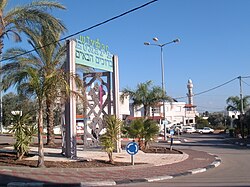Kfar Kama
Kfar Kama
|
|||
|---|---|---|---|
| Hebrew transcription(s) | |||
| • ISO 259 | Kfar Kamaˀ | ||
| • Also spelled | Кфар Кама (Adyghe) (official) | ||
 |
|||
|
|||
| Coordinates: 32°43′19″N 35°26′27″E / 32.72194°N 35.44083°ECoordinates: 32°43′19″N 35°26′27″E / 32.72194°N 35.44083°E | |||
| Grid position | 191/236 PAL | ||
| District | Northern | ||
| Founded | 1878 | ||
| Government | |||
| • Type | Local council (from 1950) | ||
| Area | |||
| • Total | 8,854 dunams (8.854 km2 or 3.419 sq mi) | ||
| Population (2015) | |||
| • Total | 3,188 | ||
| Name meaning | The village of truffles | ||
Kfar Kama (Hebrew: כְּפַר כַּמָא, Arabic: كفر كما, Adyghe: Кфар Кама) is a town located in the Lower Galilee, Israel. In 2015 it had a population of 3,188, largely Circassian.
Kfar Kama might be identified with a village Helenoupolis that Constantine established in honor of his mother Helen.
Excavations carried out in 1961 and 1963 revealed 4th century tombs. Two churches dated to the early 6th century, one dedicated to Saint Thecla, were uncovered, with multicolored mosaics of floral, animal and geometric patterns.
In the Crusader period it was known as Kapharchemme or Capharkeme.
Ruins and parts of five limestone columns have been found, together with a circular basalt olive-press and cisterns.
In 1596, Kfar Kama appeared in Ottoman tax registers as a village in the Nahiya of Tiberias in the Liwa of Safad. It had a population of 34 Muslim households and paid taxes on wheat, barley, summercrops, cotton, and goats or beehives.
A map from Napoleon's invasion of 1799 by Pierre Jacotin showed the place, named as El Hadaci.
In the 1870s, it was described as having "basaltic stone houses, containing about 200 Moslems, situated in plain of arable soil."
The current village was founded in 1878 by 1,150 Circassian immigrants from the Adyghe tribe Shapsugs who were exiled from the Caucasus by the Russians to the Ottoman Empire due to the Russian-Circassian War. Initially they made their living by raising animals, but later became farmers. The first school was established about 1880.
...
Wikipedia



